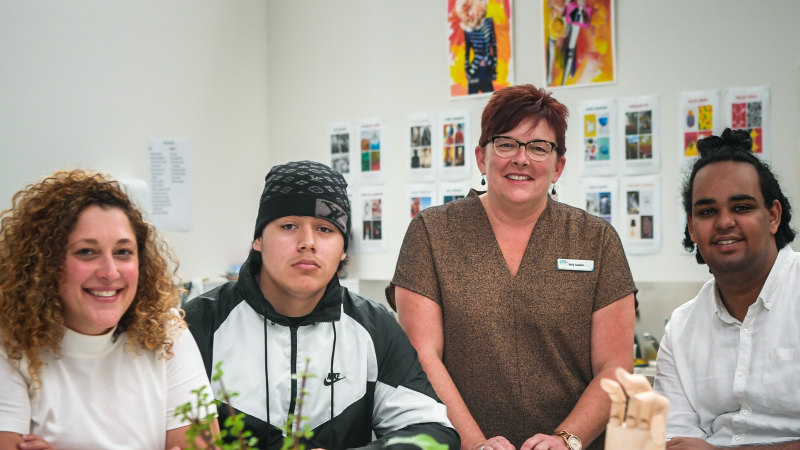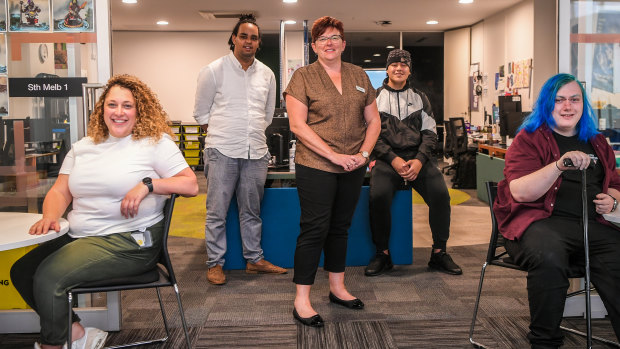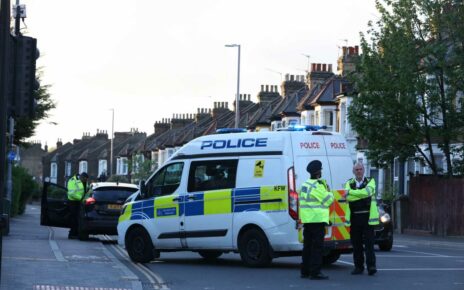Hester Hornbrook Academy is school done differently for school refusers, the students who say they simply “can’t, not won’t” attend mainstream schools.
Post the COVID-19 pandemic, demand is soaring, with the number of students enrolled across the non-government school’s campuses more than doubling in the past five years. It had 170 students in 2018 and is expected to reach 421 this year. The waitlist has doubled in the past 12 months to 78 students.
Last day of term for the new South Melbourne campus for independent Hester Hornbrook Academy. From left, support worker Amanda Haddad, student Eliud Alemayo Temesghen, principal Sally Lasslett and students Tyrese Polutele-Garrigos and Ceil McPherson.Credit: Justin McManus
Demand is so great the school is planning two further campuses, in Werribee in 2025 and Donnybrook in 2027. The first term at its newly opened South Melbourne campus, supporting 90 students aged 15 to 25, concluded on Thursday. Hester Hornbrook also operates campuses in Melbourne’s CBD, Prahran and Sunshine.
“Some of our students have not been at school for six years,” says principal Sally Lasslett.
“If a young person lives in a house where there is domestic violence, coming to school and concentrating on learning and behaving in a respectful manner is really difficult. We support these students in all manner of ways.”
School refusal is a phenomenon in which students may want to go to school, but feel they can’t due to emotional, social or sensory issues. Students may be neurodivergent, experience bullying, feel they don’t fit in, or suffer anxiety.
Hester Hornbrook youth workers meet reluctant students at home before they set foot on campus. Classes start at 10am, which Lasslett says is when the adolescent brain is more receptive to learning.
Inside classrooms, rows of desk are banned in favour of grouped desks or even beanbags. Some desks face the wall for those students who don’t like groups.
And when they graduate, they don’t leave. “They don’t want to just graduate which is really lovely, they keep coming back,” Lasslett says.
“They want to do their best to make you who you want to be,” says Tyrese Polutele-Garrigos, 15, of Deer Park, who discovered a liking for maths in his first term at the school in year 10.
“Every morning, we do a check-up. If kids are not getting the sleep that they want, they help you with that. If you are hungry and need food, they will provide you breakfast and lunch at breaks. If you need assistance, they are just here for you.”
Polutele-Garrigos plans to be a disability caretaker. “I have a brother with autism. I can use my ability to help other people out when I am older.”
The non-government school is funded by Melbourne City Mission and money from donors and state and federal governments.
In 2019, there were 14,000 people aged 14 to 25 who were not in employment, education or training. To be considered for enrolment, students must have spent at least 10 weeks disengaged – without regular attendance.
According to the Victorian government’s submission to a Senate inquiry, the rate of school refusal grew by 50 per cent in the three years between 2018 and 2021, with 11,825 students in state schools officially absent due to school refusal in 2021. Yet experts say targeted data is lacking.
In a submission to the inquiry, School Refusal Clinic director John Chellew said COVID-19 had compounded stressors, especially when students were transitioning between important school years, such as from grade 6 to 7 or into VCE.
“Many of these students completed unscored VCE exams or in some cases dropped out of school prematurely,” he said.
The In2School program supports 16 young people a year in Victoria who experience school refusal and is run by the Royal Children’s Hospital Mental Health Service, the Travancore School and the University of Melbourne.
“There has indeed been an increase in referrals to specialist mental health services for children and young people with school refusal since the pandemic,” said Dr Ric Haslam.
Lasslett said when mainstream schools couldn’t provide individualised wraparound programs for students’ specific needs, Hester Hornbrook stepped in.
“Right now, we can’t grow fast enough to meet demand,” she said.
“We need more places for students and call on the mainstream education system to work alongside us and other independent special assistance schools to support and smoothly transition young students if an alternative learning environment is what they need to thrive.
“Students who were formally fearful of returning to school are learning to code a game or develop their own podcast in our applied learning environments and are graduating secondary school with similar levels of numeracy and literacy to those learning trigonometry and reading The Crucible in traditional school environments. They just needed a different way to learn.”
Eritrean refugee Eliud Alemayo Temesghen, 18, who has epilepsy and schizophrenia, is a student at the school’s South Melbourne campus and says the environment is nurturing.
“All the stress I have in my old school – I can leave that all and come here and learn. They look inside me and try and understand me,” he said.
“I want to be psychologist because I have schizophrenia, and I know children like me and how the world sees us.
“This school is amazing. I am a satisfied customer.”
A Department of Education spokesman said government schools worked with families to support health, wellbeing and school engagement of all students.
“Schools access a range of programs and services to help vulnerable and at-risk students re-engage with their education, including Navigator, and tailored mental health and wellbeing programs,” he said.
Victoria has the highest attendance rate of all states and territories and the last budget invested $200 million for a new Schools Mental Health Fund. Its Navigator program supports young people who don’t attend school and connects them with a caseworker.
Hester Hornbrook South Melbourne student Bella Gokkaya, 15, from Preston, was enrolled in three previous high schools but suffered bad anxiety.
“I didn’t even go. And if I ever did go, I left within the first or second period.”
Gokkaya, who wants to be a skin specialist, said she had trouble with the traditional school environment.
“Mainstream school is made for one type of person, and you are meant to fit into that type of bubble. Here, the bubble fits into you.”
The Morning Edition newsletter is our guide to the day’s most important and interesting stories, analysis and insights. Sign up here.
Most Viewed in National
From our partners
Source: Read Full Article


